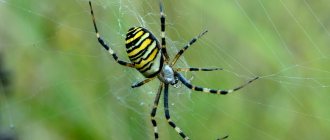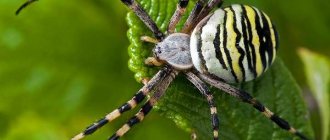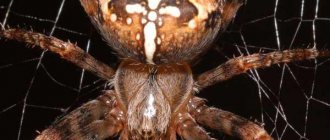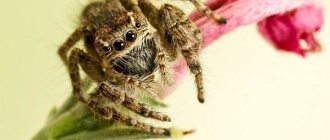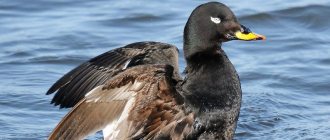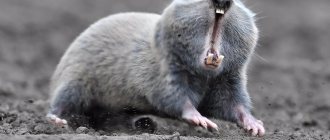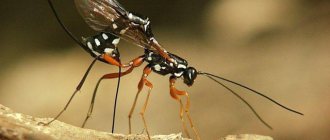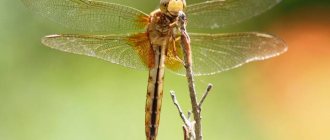Due to its coloring, the Argiope spider goes by such names as:
- wasp spider;
- zebra spider;
- tiger spider
However, its biological name is “Argiope Brünnich,” which the spider received in honor of a Dane named Morten Trane Brünnich, who lived back in the eighteenth and early nineteenth centuries and was at one time a very famous scientist in the field of zoology and mineralogy.
First, let's look at what argiope looks like in the photo.
Description and features
To describe the appearance of Argiope, we need a number of special “spider” terms.
1. First, let's introduce you to the concept of chelicerae. If translated from ancient Greek, you get two words - claw and horn. This is the first pair of limbs, or jaws, of arachnids and other arthropods. They are located in front of and above the mouth.
They usually look like claws and consist of several segments. At the tip of such claws there are ducts of poisonous glands. Now we can explain who araneomorphic spiders are - their chelicerae are located towards each other, and they fold together, sometimes overlapping one another. Such chelicerae are designed to attack large prey, sometimes larger than the hunter himself.
2. The second important term in the description of spiders is pedipalps. Translated from ancient Greek, we get two words again - leg and feel. This is the second pair of limbs, the pedicles, located on the cephalothorax (called the prosoma in chelicerates). They are located on the side of the chelicerae, and behind them there is a second pair of walking legs.
“Dismembered” into several segments, like phalanges. Adult male spiders use every last segment of the pedipalp at the moment of copulation with the female. They are transformed into a kind of sexual organ called the cymbium. It is used as a reservoir for sperm, as well as for directly introducing it into the female's genital openings.
3. And the last complex concept is stabilimentum (or stabiliment). This is a prominent thickening on the web. Usually made in the form of a zigzag weave of numerous threads at the center. There can be one, two, three or more such pronounced thickenings, depending on the type of spider.
It can be vertical in the form of a line, it can go in a circle, or it can be in the shape of a cross. Moreover, this cross is made in the form of the letter X. A very important thing for spiders, as you can see, since they constantly make it on their web. Its exact purpose has not yet been studied by people, despite numerous attempts.
Argiope weaves very strong webs that can trap medium-sized grasshoppers
Perhaps it attracts the attention of the victim, or, conversely, scares away enemies, or disguises a spider in its background. There are so many versions! The version about attracting victims is closest to the truth, especially since the purpose of the web itself is a trap. By the way, it is the stabilimentum that is best visible in ultraviolet rays, which many insects “see”.
Some spiders initially had a linear shape of the stabilimentum, but over time it became cruciform, which also speaks in favor of the version of luring prey. As they say, they do any “tuning” to achieve the desired goal.
Externally, spiders look like this:
The abdomen is entirely covered with transverse stripes of lemon and black color, with light gray stripes between them. Closer to the cephalothorax, the color completely becomes pearl gray or brown. The prosoma itself is entirely covered with a velvety-silver undercoat.
The head is black and there are four pairs of eyes on it, different in size: 2 pairs of small eyes at the bottom, 1 medium pair of large eyes looking straight ahead and 1 pair of eyes, medium in size, on the sides of the head. It also has eight paws, arranged in pairs, the first and second being the longest. The third is the shortest, and the fourth is average.
Due to its bright coloring, Argiope is called the wasp spider or tiger spider.
The size of Argiope is not the largest among spiders, but nevertheless noticeable. The females are large, body length up to 3 cm. And with the length of the legs they reach 5-6 cm. The chelicerae are small. The shape of the body is closer to an oval, the length is twice the width. There are spider warts on the abdomen. These are the organs that form the arachnoid web. This was a female Argiope that was described.
“Men” are several times smaller than “ladies”; they grow up to 0.5 cm. They look inconspicuous and, in the literal sense, gray - they are most often mouse-colored or black, without any stripes. The cephalothorax is usually without hairs, the chelicerae are even smaller than in females.
The family of orb-weaving spiders (Araneidae), which includes Argiopes, is characterized by the production of a large circular network - a catcher's web. The main radial threads are thicker; a thread running in a spiral is attached to them.
The space between us is filled with rosettes in a zigzag pattern. Argiope's web is vertical or at a slight angle to the vertical axis. This arrangement is not accidental; spiders are excellent catchers, and they know how difficult it is to get out of a vertical trap.
Skilled braiders
Like all web spiders, Argiope Brünnich prepares traps stretched between blades of grass and low branches of bushes. The networks of this species of arachnids are circular, in the center they have a zigzag-like pattern, characteristic of the weaving of all brothers in the genus Argiope and called stabilimentum. Despite the small size of the hunter, his traps are very durable, capable of holding a grasshopper, which is 2-3 times larger than the predator. Argiope Brünnich spends only an hour creating nets that are woven at sunset, in the approaching twilight.
Kinds
The Argiope spider is a genus of araneomorphic spiders from the family Araneidae. There are about 85 species and 3 subspecies in the genus. More than half of the varieties (44) are observed in the south and east of Asia, as well as on the adjacent islands of Oceania. 15 species live in Australia, 8 in America, 11 in Africa and its adjacent islands. Europe boasts only three species: Argiope trifasciata, Argiope bruennichi, Argiope lobata.
- Argiope trifasciata is perhaps the most common species on the planet. It was first described by Per Forsskol in 1775. In Europe, it is observed on the Perinean Peninsula, the Canary Islands and the island of Madeira. The greatest activity is in September-October, when the summer heat subsides.
- Argiope bruennichi ( Argiope Bruennichi ) The name was given in honor of the Danish zoologist and mineralogist Morten Trane Bruennichi (1737-1827), who discovered it. By the appearance of this spider one can make a description of the entire genus of Argiope. The dorsal pattern of the abdomen in the form of black and yellow stripes has led to it being called the argiope wasp spider . In addition, it is also called the zebra spider and the tiger spider.
Sometimes it is also called Argiope three-striped , based on the number of yellow stripes on the body. And of course, we are talking about females; we already know that men do not have such brightness. A characteristic feature is that it spreads with the help of its own web, flying on it on air currents. Therefore, it can be found not only in the southern regions, but sometimes much further north than usual. As they say, whichever way the wind blows.
More often it inhabits desert dry places and steppes. If we clarify the geographical location of populations, we can list;
- Europe (southern and central);
- North Africa;
- Caucasus;
- Crimea;
- Kazakhstan;
- Central and Asia Minor;
- China;
- Korea;
- India;
- Japan.
- In Russia, the northern border passes beyond 55ºN. Most often found in the Central and Central Black Earth regions.
Perhaps due to general climate warming, this spider is moving further north. He is comfortable in meadows and roadsides, forest edges; he chooses sunny and open places. Does not like moisture, prefers dry areas. Settles on shrubs and herbaceous plants. The wasp spider has two stabilimentum in its web; they are located linearly opposite each other, like radii from the center of the web.
Argiope spider is small, maximum size is about 7 cm.
- Argiope lobata ( Argiope lobata ) reaches a size of up to 1.5 cm in females. The abdomen is white and silvery with six deep indentations-lobules, the color of which varies from dark brown to orange. Due to this, it is also called argiope lobata . The web is in the shape of a wheel, the center is densely woven with threads. On the territory of the former Soviet Union, it lives in the Crimea and the Caucasus, in Central Asia and Kazakhstan and, of course, in the European part. Also found in Algeria (northern Africa).
- I would like to highlight one more species in this genus – Argiope ocular. Outwardly, he does not look like his relatives. Its abdomen is red, without yellow-black stripes, and its legs are also red. On the legs, the last two segments are black, with one white segment in front of them.
All covered with hairs, on the cephalothorax they are silvery. Lives in Japan, Taiwan, mainland China. This species, in addition to external characteristics that are uncharacteristic of the genus, is distinguished by one more quality. They often have males that survive without both segments of the pedipalps. In other words, after the second intercourse. And this is a huge rarity in the world of spiders. We'll tell you why a little later.
Spreading
The wasp spider lives in Europe, Africa and Asia.
It can be found in the following countries:
Albania, Algeria, Austria, Azerbaijan, Belarus, Belgium, Bosnia and Herzegovina, Bulgaria, Croatia, Czech Republic, China, Denmark, Estonia, Egypt, Finland, France (including Corsica), Gambia, Georgia, Jordan, Japan, Germany, Greece ( also on Crete), Hungary, Iraq, Iran, Indonesia, Italy (including islands), Israel, Latvia, Liechtenstein, Lithuania, Luxembourg, Malta, Moldova, Montenegro, Morocco, Netherlands, North Macedonia, Norway, Poland, Portugal, Romania, Russia, Serbia, Slovakia, Slovenia, Syria, Spain (including the Balearic Islands), Sweden, Switzerland, Thailand, Tajikistan, Kyrgyzstan, Turkmenistan, Tunisia, Turkey, Ukraine, Uzbekistan, Vietnam, Kazakhstan and the UK.
In Russia you can even find it in the Moscow region, for example, near the city of Serpukhov.
Female wasp spider, close up
Lifestyle and habitat
Argiope lives everywhere except the Arctic and Antarctica. It builds webs in spacious places where there are a lot of flying insects and, therefore, potentially good hunting. In addition, the chosen location should be clearly visible at any time of the day. Another plus in favor of the “attractive” role of the web and stabilimentum in the center. The weaving process takes only about an hour, usually in the twilight evening or early morning hours.
Usually the spider does not make any more shelters near the web, but sits in its center. Most often this place is occupied by a female. She spreads her paws in different directions along the web, visually resembling the shape of the letter X, waiting for prey. Argiope in the photo looks both beautiful and dangerous at the same time.
Beauty is created by a finely spun web, a spreading, motionless pose in the shape of a cross, and, of course, a bright color. Only this brightness is frightening. As you know, in the animal world there is a principle - the brighter, the more poisonous and dangerous. Cute and harmless creatures always try to be more invisible in nature.
Sometimes, sensing danger, spiders quickly move along the threads, hiding from predators. Others quickly “fall” to the ground with their belly up, which becomes darker and more inconspicuous due to the reduction of special cells. They always have a saving thread ready in their spider warts, on which they quickly fall to the ground.
During the day he is lethargic, apathetic, in the evening he begins an active, promising life. In a home terrarium, the spider needs to sprinkle coconut shavings or any substrate for spiders on the bottom, which needs to be changed periodically.
And place several branches inside, preferably grape branches, on which he will weave a web. The walls of the terrarium also need to be regularly wiped with an antiseptic to remove fungi and other bacteria. Just don't disturb his secluded places.
Nutrition
The Argiope's fishing net is distinguished not only by its beautiful shape and design, but also by its meticulous execution. In particular, the small size of individual cells. Even the smallest mosquito cannot break through such “windows”. Therefore, her lunch consists of unfortunate insects that got caught in this net.
It feeds on Orthoptera and various other insects. These are grasshoppers, crickets, grasshoppers (locusts), butterflies, midges, quails and jumpers. And also flies, bees, mosquitoes. The victim does not see the spider, or mistakes it for a wasp that is hovering in the air. The spider in the center of the web often repeats the shape of the stabilimentum and merges with it, only the striped body is visible. The prey begins to fight in the web, the signal thread gives a sign to the predator.
Argiope envelops prey in a cocoon and bites the victim
He quickly runs up to his prey and injects his paralyzing poison. Then he wraps the poor fellow in a cocoon and drags him to a secluded place. After a short time, it draws out juices from the body that has begun to dissolve. By the way, at home he eats the same as in captivity. Food should be given once every two days. Just, despite his love for dry climates, do not forget to give him water. And sometimes spray water into the aquarium on especially hot days.
Argiope Brünnich: keeping in the house
Thanks to the spectacular appearance of the female, the spider attracts the attention of lovers of exotic pets. Some people keep such a spider as their pet.
To keep Argiope at home, you need an aquarium in which the lid and one of the walls are covered with a fine mesh. Dry grape branches can be placed inside. They need to be sprayed only on the hottest days.
It is better to keep one spider in the aquarium, because if there are several of them, they will begin to attack each other, which will lead to the death of one of them.
You need to feed the spider once every 2 days. Various insects are suitable as food; they can be bought at a pet store.
Reproduction and lifespan
They become ready for procreation immediately after the last molt. At this time, in “girls” the chelicerae are still soft. During mating, the girlfriend wraps the partner in a web, and if he cannot then free himself, his fate is unenviable, he will be eaten. By the way, I would like to voice a certain theory about the notorious cruelty of female spiders here.
There is an assumption that the male deliberately gives himself up to be torn to pieces, supposedly thereby consolidating his position as a father. The female, having eaten the body of the unfortunate admirer, becomes satisfied and does not look for more adventures, but calmly engages in fertilization. It turns out that she herself is not against keeping the sperm of this particular applicant in herself. This is such “monstrous love”.
As a mother, she then performs at her best. She weaves a large cocoon, which is located not far from the main web, and hides eggs in it. Outwardly, these “nurseries” resemble the seed capsule of a certain plant. There are up to hundreds of eggs in a cocoon. The mother carefully guards the cocoon.
Argiope weaves a kind of cocoon in which about 300 eggs are kept and overwintered.
Children leave the “nurseries” at the end of August – beginning of September and actively disperse through the air on spider webs. There is another option for the development of events. Sometimes the spider lays eggs in late autumn and leaves this world. And the spiderlings are born and fly away in the spring. The life of Argiope is short, only 1 year.
Danger to humans
We immediately warn those who are interested in extreme sports - if you touch the web of an argiope with your hand, it will react and will definitely bite. Argiope's bite is painful and can be compared to a wasp or bee sting. This spider has very powerful jaws; it can bite quite hard.
In addition, we must not forget about its poison. Many people are interested in the question: is argiope poisonous or not ? Of course, it is poisonous; it is with this toxin that they provide themselves with food by killing their victims. Has a paralyzing effect on invertebrates and vertebrates.
The second question is that the poison is not dangerous for humans and large animals. Spider venom contains argiopine, argiopinin, pseudoargiopinin, but in small doses that do not pose any particular harm to humans.
The consequences of this bite are not fatal, but can cause a number of significant inconveniences and troubles. Most people experience redness and slight swelling near the site of the bite, which goes away within a couple of hours.
But it happens that these signs disappear only after a day, and the bite can be very itchy. But if you have a weakened immune system, have an allergic reaction, or have a child with you who has been bitten by a spider, then the consequences can be unpleasant:
- The bite site swells noticeably;
- Body temperature rises, sometimes quite significantly, up to 40-41 degrees;
- Nausea and dizziness begin.
There is only one way out - immediately see a doctor. No “it will go away later” or “I’ll heal myself.” Don't risk your life. And as first aid, cauterize the bite site and give an antihistamine. And drink plenty of water.
The benefits and harms of the spider
As we have already said, this spider does almost no harm to humans. If you don't offend him yourself. It just litters open spaces with its web, slightly interfering with a carefree walk. But this is not a harm, just a minor inconvenience.
But it has great benefits. It can catch up to 400 harmful insects in its nets per day. Therefore, do not rush to destroy them if you see them in a meadow or forest edge. In the forest, in the garden or in the vegetable garden, these tireless orb weavers weave their nets and catch springtails, leaf rollers, bugs, aphids, caterpillars, mosquitoes, flies and other harmful insects in them.
Spiders are voracious; in a day they eat as much as their own weight. So consider how much benefit this ecological insect trap can bring over the summer. In addition, according to ancient Eastern philosophy, the spider brings good luck.
Argiope bites are painful, but not capable of causing significant harm to humans.
Notes
- ↑ Platnick, N.I. (2010). . The world spider catalog, version 11. American Museum of Natural History. (English) (Retrieved January 4, 2011)
- ↑ Westheide V., Rieger R. From protozoa to mollusks and arthropods // Zoology of invertebrates. = Spezielle Zoology. Teil 1: Einzeller und Wirbellose Tiere / trans. with him. O. N. Bölling, S. M. Lyapkova, A. V. Mikheev, O. G. Manylov, A. A. Oskolsky, A. V. Filippova, A. V. Chesunov; edited by A. V. Chesunova. - M.: Partnership of Scientific Publications KMK, 2008. - T. 1. - P. 494. - iv+512+iv p. — 1000 copies. — ISBN 978-5-87317-491-1.
- ↑ Lange A. B. subtype Chelicerata (Cheilcerata) // Animal Life. T.2. Invertebrates. - M.: Education, 1968. - P.10-135.
- ↑ 1234567
Ivanchev V.P., Kazakova M.V. (2011) Red Book of the Ryazan Region. Ryazan: NP "Voice of the Province" ed. 2 - 626 s. - ↑ Esyunin S. L., Efimik V. E. Catalog of spiders (Arachnidae, Aranei) of the Urals. In English. and Russian language. resp. Ed. K. G. Mikhailov. - M.: KMK 1996. - 229 p.
- ↑ Tyshchenko V.P. Identifier of spiders of the European part of the USSR. L.: Nauka, 1971. 281 p.
- ↑ 12
Tyshchenko V.P. Identifier of spiders of the European part of the USSR. In the series “Key guides to the fauna of the USSR, published by the Zoological Institute of the Academy of Sciences of the USSR No., no. 105. - L.:. Science, 1971. - 281 p. - ↑ Arkhipov V. Yu, Mikhailov KG First Record of the Striped Argiopa, Argiope bruennichi in Novgorod Region, Russia (Aranei, Araneidae) // Vestnik zoologii. — 2015. — Vol. 49, No. 5. - P. 477. - DOI:.
- ↑ Red Book of the Kaluga Region. — Kaluga: Golden Alley, Volgograd and Astrakhan regions. 2006. — 608 p.
- Azheganova N. S. A short guide to spiders (Aranei) of the forest and forest-steppe zones of the USSR. L.: Nauka, 1968. 149 p.
This page was last edited on March 26, 2019 at 06:24.
The wasp spider's favorite habitats are located in areas exposed to the sun: fields, lawns, along roadsides, forest clearings and forest edges. The black-and-yellow striped wasp spider places its hunting nets on various low vegetation, giving particular preference to xerophilous plants growing in particularly dry areas of the area.
A unique feature of all orb weavers, including the wasp spider, is their ability to move considerable distances thanks to their web threads, picked up by rising air currents. This manner of settlement has led to the fact that some southern populations often end up in northern territories.
Photo credit: EapClochydd
Interesting Facts
- In Japan, spider fights are held, and this particular type of spider often appears there.
- In some people, spiders cause an excessive fear, which is called arachnophobia. This feeling arises at the genetic level, coming out of the most ancient times, when almost all arachnids were dangerous. Argiope does not have such dangerous qualities; she is more attractive than scary. However, people with the above-described disease should not get it.
- After mating, males often cut off the cymbium (the last segment of the pedipalp), this is called autotomy (self-cutting of the organ) at the moment of mating. Probably to escape in time. This embolus (fragment), sometimes with additional segments, clogs the female's genital opening. Thus, if this male manages to escape from the cannibalism of the female, he can impregnate one spider again. After all, he still has one more cymbium left. But most often they do not survive after the second mating.
- The Argiope spider is one of the fastest weavers. It creates a network with a radius of up to half a meter in 40-60 minutes.
- It is instructive that “Indian summer” with cobwebs is the time of settlement of young spiders. They are the ones flying on their “air mats” when this wonderful time begins.
- During archaeological excavations in Africa, a web about 100 million years old was discovered in frozen amber.
- Argiope spiders use a “fragrant” bait for victims. This assumption was made by Australian scientists after conducting a series of experiments. He applied a solution of putressine, which the spider uses to “flavor” the thread, onto the surface being examined. The catch doubled.
Lifestyle
The bee spider does not survive alone, and therefore joins the flock: this makes it easier to get food and reproduce. Matriarchy reigns in the Argiope family. The main “mistress of the house” - the spider - chooses the place of future housing, mobilizes other individuals to create net traps for hunting.
Each member of the flock is given no more than 60 minutes to create a web that is not only durable, wide-format (up to half a meter), but also attractively lacy. Even a small mosquito should not slip through it. Spiders cope.
The algorithm for catching and eating food is the same for all arthropods:
- To prevent the victim caught in the snare from tearing the web, the argiope inflicts a poisonous bite on it and injects its digestive enzymes into it.
- The paralyzed insect stops resisting.
- Enzymes dissolve the insides of prey, turning them into a liquid substance.
- Argiope Brünnich waits until the food is “infused” and becomes suitable for consumption, after which it sucks it out, leaving only the dry shell of the insect’s body in the web.
When the remains of prey accumulate in the nets of a striped animal, it leaves them and scatters its hunting gear in a new place in order to lull the vigilance of future potential victims.
